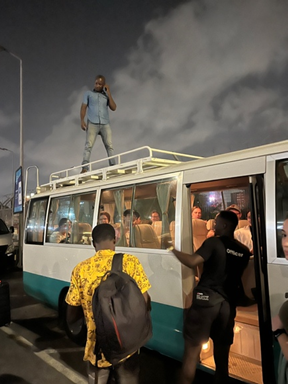Twist and Turns: My heart broke
Hello Readers!
I am Izzy Basurto Poferl, a senior at St. Thomas, and today I have the opportunity to write the blog for our travels. Our venture today was a little different – it was an emotionally heavy day. The title of today’s blog “Twist and Turns” ties to the site we visited, the Nkyinkyi Museum, which our guide explained translates to “twist and turns.” Walking into today, we could never have known the way this site would truly twist and turn our own minds.
When you think of a museum, you might imagine large
gallery walls and bright lights highlighting various paintings, sculptures, and
more. This was not that sort of museum. The Nkyinkyi Museum is an outdoor
sculpture museum that takes you through various aspects of African culture and
history with pieces made by Kwame Akoto-Bamfo. At the entrance of the museum, we
discovered the use of symbolism in art through the use of animals, insects, and
religious symbols. We also learned some about the process of making sculpture
art through the use of mediums such as silicone molds and the need to burn down
brass material to make the finished product. After the studio tour, we were led
to the ancestral site.
This sacred ground is exactly as it sounds. Before
entering the area, our tour guide sprinkled three lines of water on the ground
and called out “Agoo” three times. “Agoo” is a traditional word you say when
entering someone’s home. In this context, our guide explained he did this to
call out to the ancestors out of respect before we entered the sacred site.
This practice is significantly different from what most
of us in our group are accustomed to. I considered my own ancestors and
practices back home surrounding respect for those who have died. I questioned
how often we think about the people who have come before and paved the way for us.
Some things I pondered included: How often do we visit the grave of a loved one?
How many of us pray for our loved ones? How do we honor those who have come
before us? This experience made me take a step back and appreciate how much
respect is given to deceased individuals here in Ghana. Their reverence for
those who came before is truly beautiful.
The ancestral site is host to 3,000 sculptures –
busts of individuals victimized in slavery – and four significant posts
representing 400 years of slavery. Our guide informed us that the sculptures depicted
ancestors who were abruptly taken from their daily lives whether they were old,
young, men, women, children, kings and queens. Next, he walked us over to a
small pond representing those who had drowned during the Atlantic Slave Trade.
Some sculptures had bands over their eyes, others had hoods over their faces, and still others had metal collars. Not only was the pain evident in the faces of these sculptures; the space became heavy on my chest as I imagined what these people endured both physically and mentally as they suffered. As we walked out of the site and back down the path, there was a quiet stillness. We walked a little slower, a little more scattered apart, and somehow changed from when we first walked in.
The end of the tour brought us to murals and more
sculptures that highlighted Africans who have used art as a platform to spread
themes of struggle, strength, and culture. When confronted with our own
reflection in a massive mirror, we acknowledged our own part in the struggles that African and Black people across the world
face. As we departed the museum, we each rang the bell
of responsibility signifying that we are each accountable to share what we
have learned and to treat every human being with benevolence. The bus ride home
gave me a lot to think about.
Upon our return to the SIT building, we reflected as
a group, sharing our feelings of guilt, anger, confusion, shock, and
indescribable sadness.
Izzy








Comments
Post a Comment